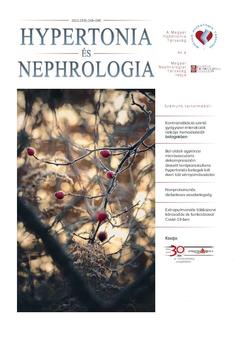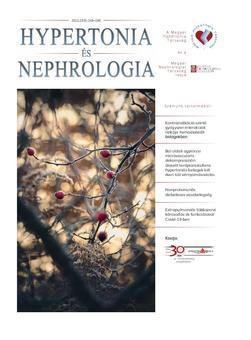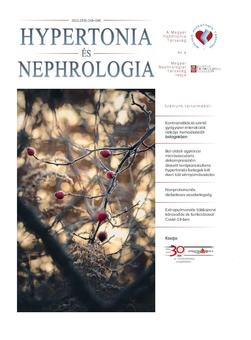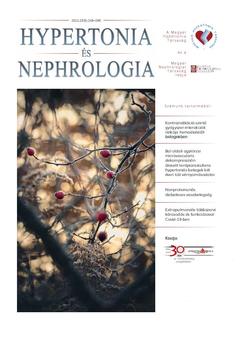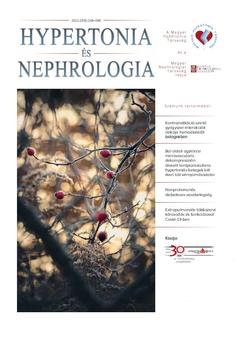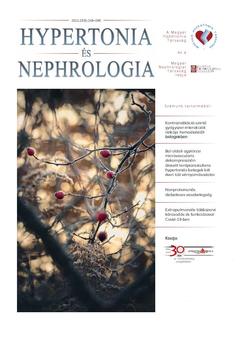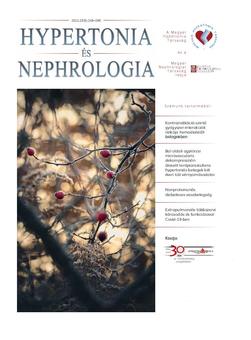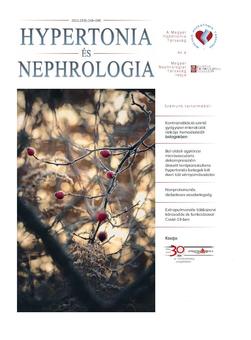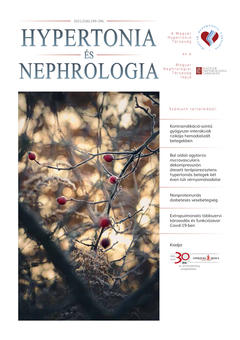The eLitMed.hu medical portal uses computer cookies for convenient operation. Detailed information can be found in the Cookie-policy.
Hypertension and nephrology - 2021;25(06)
Content
[Risk of drug-drug interactions in hemodialyzed patien]
[Hemodialysis patients usually need large number of medications fór treatment of their multiple comorbidities. Because of the polypharmacy we have to count on several drug-drug interactions, which might necessitate modification of types and dosages of drugs, based on the patient's actual condition and current treatment. The use of anticoagulants causes everyday problems, because these drugs have high pharmacokinetics potency, and on the other hand their administration is indispensable. In our investigation we aimed to analyze the drug therapy of chronic hemodialysis patients in the Szent Margit Hospital Taraba István Dialysis Unit, and present the clinical pharmacist's role in the hospital team.]
[Data on blood pressure over two years in resistant hypertensive patients with lett brain stem microvascular decompression]
[In the background of resistant hypertension (RHT) the neurovascular pulsatile compression (NVPC) of the left rostral ventrolateral medulla may play a role. In these cases a microvascular decompression (MVD) may decrease the blood pressure (BP). The aim of this work was to investigate how the BP has changed after the MVD in the operated patients recorded at the farthest time from the MVD up to maximum 31 December 2016. We have retrospectively collected data from 9 patients whose follow-up data fór 2 years has already been published earlier. Data collection was carried out from the patient register program of the University of Szeged Albert-Szent Györgyi Clinical Centre. The MVDs were performed between 2000 and 2004. The mean follow-up time was 11.1±4.6 years. Both the systolic and the diastolic BPs were significantly lower at the time of last record compared to the BPs at the time of MVD (systolic BP 211±40 vs. 135±20 mmHg, p=0.003; diastolic BP 116±17 vs. 81±14 mmHg, p=0.007). Last recorded BPs compared to the 24-month data alsó were lower bút nőt signffi- cantly (systolic BP 148±32 vs. 135±20 mmHg, p=0.25; diastolic BP 96 vs. 85 mmHg, p=0.11). The mean number of antihypertensives at the last Office visít was nőt sig- nificantly higher compared to MVD (5.9±1.4 vs. 6.3±1.5; p=0.5) bút signfficantly increased compared to MVD +1 month data (4.7±0.9vs. 6.3±1.5; p=0.03). These results confirmed our previous opinion that in severe RHT nőt respond- ing to conventional therapy an MVD of the left side NVPC could be a therapeutic option and may guarantee a long-lasting BP reduction. Evén if the number of antihypertensives increased in the meantime, as they still responded better to therapy. ]
[Changes in systolic blood pressure in the Hungárián aduit population between 2010 and 2018 based on public health screening data]
[Using our mobile public health screening system, we examined the changes in systolic blood pressure averages and systolic pressure distribution between 2010 and 2018 by analyzing the data of 72,857 women (mean age 42.3±13.9 years) and 61,563 mén (mean age 42.2±13.9 years) in three consecutive time periods. The SBP averages have been gradually and significantly decreased since 2010 in all age groups. The parametric and non-parametric characteristics of the systolic distribution curves alsó showed a favorable change during the indicated period. The observed changes may indicate that the primary and secondary prevention, as well as the treatment of hypertension and the physician-patient cooperation in Hungarywere successful in the indicated period.]
[Nonproteinuric diabetic kidney disease]
[Diabetic nephropathy is one of the most common causes of chronic kidney disease. In recent years, besides the classic phenotype with increased urinary albumin excretion, another phenotype showing Progressive kidney failure without albuminuria has been observed with increasing frequency. The histology, the pathophysiology and the course of non-proteinuric diabetic kidney disease differs from the classic phenotype in several respects. The former shows traits similar to atherosclerotic kidney disease with respect to association with cardiovascular disease and histological alterations and the progression is slower. This has important implications concerning the screening, treatment and prognosis of the disease. While the available data about non-proteinuric diabetic nephropathy is relatively scant, it deserves attention both in everyday clinical practice and in scientific research.]
[Extrapulmonary multiple organ damage and dysfunction in Covid-19]
[SARS-CoV-2 virus attacks nőt only the lungs bút alsó many other or- gans (heart, kidney, liver, pancreas, gastrointestinal tract, brain, hematopoiesis) and regulatory system (RAAS, immuné system) to different degrees and with dif- ferent pathomechanisms. Accordingly, cell death, tissue damage and dysfunction or failure of somé organs has been developed. Our paper provides a detailed analysis of the incidence of extrapulmonary lesions, clinical manifestations, and the underlying pathomechanisms. This multi-organ damages was detected dom- inantly in severe Covid cases, bút may occur in moderate or mild cases. It should alsó be taken intő account that the consequences may occur after the acute phase, in a seronegative State - months after the onset of infection. In particu- lar, the heart (myocarditis, coronary insufficiency, arrhythmia), the kidney (acute renal failure and then permanent GFR decrease), glucose metabolism disorder (diabetes worsening, ketoacidosis, new diabetes) are the biggest therapeutic challenge. Multi-organ damage is due to direct virus-induced cell death, endo- thelial cell damage in the vascular system, and thrombo-inflammation with the formation of microthrombi, imbalance in the RAAS regulatory system, and early and delayed abnormal immuné response (cytokine storm).]
1.
Clinical Neuroscience
Is there any difference in mortality rates of atrial fibrillation detected before or after ischemic stroke?2.
Clinical Neuroscience
Factors influencing the level of stigma in Parkinson’s disease in western Turkey3.
Clinical Neuroscience
Neuropathic pain and mood disorders in earthquake survivors with peripheral nerve injuries4.
Journal of Nursing Theory and Practice
[Correlations of Sarcopenia, Frailty, Falls and Social Isolation – A Literature Review in the Light of Swedish Statistics]5.
Clinical Neuroscience
[Comparison of pain intensity measurements among patients with low-back pain]1.
Clinical Neuroscience Proceedings
[A Magyar Stroke Társaság XVIII. Kongresszusa és a Magyar Neuroszonológiai Társaság XV. Konferenciája. Absztraktfüzet]2.
3.
Journal of Nursing Theory and Practice
[A selection of the entries submitted to the literary contest "Honorable mission: the joys and challenges of our profession" ]4.
Journal of Nursing Theory and Practice
[End of Life and Palliative Care of Newborns in the Nursing Context]5.
Journal of Nursing Theory and Practice
[Aspects of Occupational Health Nursing for Incurable Patients ]



